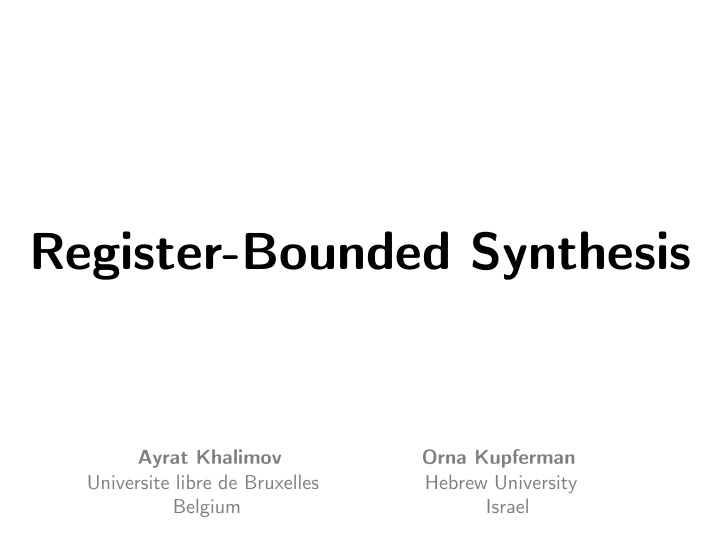



Register-Bounded Synthesis Ayrat Khalimov Orna Kupferman Universite libre de Bruxelles Hebrew University Belgium Israel
Why study bounded synthesis from universal automata?
why register- bounded synthesis? • Not a limitation: designer usually knows the sensible bound on the number of registers • Added benefit: small programs
why universal register automata? system All computations (𝑗𝑜 0 , 𝑝𝑣𝑢 0 ) (𝑗𝑜 1 , 𝑝𝑣𝑢 1 ) (𝑗𝑜 2 , 𝑝𝑣𝑢 2 ) … satisfy a given specification.
why universal register automata? system All computations (𝑗𝑜 0 , 𝑝𝑣𝑢 0 ) (𝑗𝑜 1 , 𝑝𝑣𝑢 1 ) (𝑗𝑜 2 , 𝑝𝑣𝑢 2 ) … satisfy a given specification. Most specifications are derived from arbiter: ∀𝑒 ∈ 𝐸: 𝐇(𝑠𝑓𝑟 ∧ 𝑗 = 𝑒 → 𝐘 𝐆(𝑠𝑏𝑜𝑢 ∧ 𝑝 = 𝑒))
why universal register automata? system All computations (𝑗𝑜 0 , 𝑝𝑣𝑢 0 ) (𝑗𝑜 1 , 𝑝𝑣𝑢 1 ) (𝑗𝑜 2 , 𝑝𝑣𝑢 2 ) … satisfy a given specification. Most specifications are derived from arbiter: ∀𝑒 ∈ 𝐸: 𝐇(𝑠𝑓𝑟 ∧ 𝑗 = 𝑒 → 𝐘 𝐆(𝑠𝑏𝑜𝑢 ∧ 𝑝 = 𝑒)) Universal register automata can express this. Nondeterministic -- cannot.
universal register automaton • Works on words in Σ × 𝐸 × 𝐸 𝜕 • Registers 𝑆 = {𝑠 1 , … , 𝑠 𝑙 𝐵 } , initialized 𝑤 0 • Transition function 𝑅 × Σ × 𝑈𝑡𝑢 𝑗 × 𝑈𝑡𝑢 𝑝 → 2 𝑅×𝐵𝑡𝑜 Arbiter specification (coBuchi)
universal register automaton 𝑠𝑓𝑟,1 ¬𝑠𝑓𝑟,2 ¬𝑠𝑓𝑟,3 ¬𝑠𝑏𝑜𝑢,1 … • Word: ¬𝑠𝑏𝑜𝑢,0 𝑠𝑏𝑜𝑢,1 • Run-graph: 𝑟 0 , 0 𝑟 0 , 0 𝑟 0 , 0 𝑟 0 , 0 𝑟 1 , 1
register transducer • Reads a letter in Σ 𝐽 × 𝐸 • Outputs a letter in Σ 𝑃 × 𝐸 • Registers 𝑆 = {𝑠 1 , … , 𝑠 𝑙 𝑡 } , initialized with 𝑤 0 • Transition function 𝑇 × Σ 𝐽 × 𝑈𝑡𝑢 𝑗 → 𝑇 × Σ 𝑃 × 𝑆 × 𝐵𝑡𝑜
arbiter • Input: 𝑠𝑓𝑟, 1 ¬𝑠𝑓𝑟, 2 ¬𝑠𝑓𝑟, 3 … ¬,0 𝑡 1 , 1 ,1 𝑡 0 , 1 ¬,1 𝑡 0 , 1 … • Run: (s 0 , 0)
bounded synthesis problem Given: • Σ 𝐽 , Σ 𝑃 • universal register automaton 𝐵 over Σ 𝐽 × Σ 𝑃 × 𝐸 × 𝐸 • the number 𝑙 𝑡 of system registers Return: • 𝑙 𝑡 -register transducer 𝑈 such that 𝑈 ⊨ 𝐵 , or “unrealizable” Bounded synthesis problem is solvable in EXP in 𝑅 and 𝑙 𝑡 , and 2EXP in 𝑙 𝐵 .
abstraction 𝑩′ 𝑡 → 𝑇 × Σ 𝑃 × 𝑆 𝑡 × 𝐵𝑡𝑜 𝑡 𝑈: 𝑇 × Σ 𝐽 × 𝑈𝑡𝑢 𝑗 ′ → 𝑇 × Σ 𝑃 ′ 𝑈 ′ : 𝑇 × Σ 𝐽 𝚻 𝑷 𝚻 𝐉 𝑼′ 𝑩𝒕𝒉𝒐 𝒕 𝒕 𝑼𝒕𝒖 𝒋 𝑺 𝒕 We construct register- less automaton 𝐵 ′ with ′ × Σ 𝑃 𝑅 ′ × Σ 𝐽 → 2 𝑅 ′ ′ such that 𝑈 ′ ⊨ 𝐵′ iff 𝑈 ⊨ 𝐵 for every 𝑈 or 𝑈 ′ .
abstracting a single transition
abstracting a single transition 2 2 2 2 2
abstracting a single transition 1 1 2 2 2 2 2 1
abstracting a single transition
abstracting a single transition
abstracting a single transition Two possibilities: • 𝑗 = 𝑠 𝑈 • 𝑗 ≠ 𝑠 𝑈
abstracting a single transition Two possibilities: • 𝑗 = 𝑠 𝑈 • 𝑗 ≠ 𝑠 𝑈
abstracting a single transition
one 𝑢𝑡𝑢 𝑡 can induce several 𝑢𝑡𝑢 𝐵
bisimulation property of the abstraction transition 𝑡 , 𝑠 𝑢𝑡𝑢 𝑗 𝑡 , 𝑏𝑡𝑜 𝑡 of 𝐵 ′ and 𝑟, 𝜌 𝑟′, 𝜌′ some 𝑈 ′ transition 𝒋, 𝒑 ′ , 𝒘 𝒕 ′ 𝒓 ′ , 𝒘 𝑩 of 𝐵 and 𝑟, 𝑤 𝐵 , 𝑤 𝑡 some 𝑈
bisimulation property of the abstraction transition 𝒕 , 𝒔 𝒕 , 𝒃𝒕𝒉𝒐 𝒕 𝒖𝒕𝒖 𝒋 of 𝐵 ′ and 𝑟, 𝜌 𝒓′, 𝝆′ some 𝑈 ′ transition 𝑗, 𝑝 ′ , 𝑤 𝑡 𝑟 ′ , 𝑤 𝐵 ′ of 𝐵 and 𝑟, 𝑤 𝐵 , 𝑤 𝑡 some 𝑈
• For every 𝑈 or 𝑈 ′ : 𝑈 ′ ⊨ 𝐵′ iff 𝑈 ⊨ 𝐵 • Recall that synthesis is EXP in |𝑅 ′ | • 𝑅 ′ = 𝑅 × Π , where Π is the set of partitions of 𝑆 = 𝑆 𝑡 ∪ 𝑆 𝐵 • Π is EXP in (𝑙 𝑡 + 𝑙 𝐵 ) => synthesis is 2EXP in 𝑙 𝑡 and 𝑙 𝐵 But system partitions behave deterministically => only EXP in 𝒍 𝒕
Part 2
environ system ment register register transducer transducer Environments have their own limits. Let them be register transducers. 𝑓𝑜𝑤||𝑡𝑧𝑡 = 𝑗𝑜 0 , 𝑝𝑣𝑢 0 𝑗𝑜 1 , 𝑝𝑣𝑢 1 … Note: the number of values is at most 𝑙 𝑡 + 𝑙 𝑓 .
env-sys-bounded synthesis problem Given: • Σ 𝐽 , Σ 𝑃 • universal register automaton 𝐵 with Σ 𝐽 and Σ 𝑃 • the number 𝑙 𝑡 of system registers • the number 𝒍 𝒇 of environment registers Return: • 𝑙 𝑡 -register transducer 𝑡𝑧𝑡 such that 𝑓𝑜𝑤||𝑡𝑧𝑡 ⊨ 𝐵 for every 𝑙 𝑓 -register environment, or “unrealizable” Env-sys-bounded synthesis problem is solvable in EXP in |𝑅| and 𝑙 𝑡 , 2EXP in 𝑙 𝐵 and 𝒍 𝒇 .
idea of the abstraction 𝑟 0 , 𝑠 𝐵 = 𝑠 𝑈 = 𝑠 𝑓 ( 𝑡𝑢𝑝𝑠𝑓 𝑓 ) 𝑟 0 , 𝑠 𝐵 = 𝑠 𝑈 ≠ 𝑠 𝑟 0 , 𝑠 𝐵 = 𝑠 𝑈 = 𝑠 𝑓 𝑓 similarly…
conclusion • Cleaner algorithm => tighter complexity analysis (only EXP in 𝑙 𝑡 ) • Solution to the environment-system-bounded synthesis problem In the full version: • Non-determinacy • Hierarchy of system and environment power

Recommend
More recommend